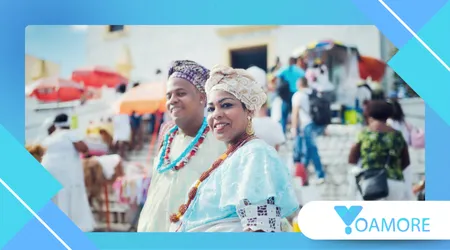Afrobrasilianischer Candomblé: Ritual, Widerstand und Gemeinschaft

In der komplexen Kulturlandschaft Brasiliens Afro-brasilianischer Candomblé sticht nicht nur als Religion hervor, sondern auch als verschlüsselte Sprache des Widerstands, der Erinnerung und der Identität.
Anzeigen
Candomblé ist aus der Weisheit afrikanischer Vorfahren entstanden und durch Jahrhunderte der Widerstandsfähigkeit geformt. Es ist mehr als nur ein Ritual – es ist eine Art, die Welt mit Ehrfurcht und Absicht zu bewohnen.
Dieser Artikel untersucht die Wurzeln, Ausdrucksformen und die zeitgenössische Relevanz dieser spirituellen Praxis.
Wir werden aufdecken, wie Rituale generationenübergreifendes Wissen bewahren, wie Terreiros widerstandsfähige Gemeinschaftsnetzwerke bilden und wie Candomblé weiterhin Unterdrückungssysteme herausfordert und gleichzeitig in der modernen Gesellschaft floriert.
Ein Glaube, der auf Überleben beruht
Der Candomblé kam nicht auf Einladung nach Brasilien – er überlebte durch Gewalt.
Anzeigen
Versklavten Afrikanern, vor allem aus West- und Zentralafrika, war die Ausübung ihrer Religion verboten. Doch der Glaube erwies sich als mächtiger als die Unterdrückung.
Statt sie auszulöschen, passte sie sich an. Die Yoruba-Orixás wurden mit katholischen Heiligen verehrt. Hinter den Mauern der Plantagen wurden heilige Gesänge geflüstert.
Diese Vermischung – bekannt als religiöser Synkretismus – war keine Unterwerfung, sondern eine Strategie. Durch die Einbettung afrikanischer Kosmologien in koloniale Strukturen schützten die Praktizierenden ihre spirituelle Kontinuität.
Auch heute noch fallen viele Candomblé-Feste mit den Daten des katholischen Kalenders zusammen, was diesen vielschichtigen Widerstand widerspiegelt.
Im Wesentlichen, Afro-brasilianischer Candomblé ist das spirituelle Äquivalent eines Palimpsests: Hinter jeder aufgezwungenen Erzählung liegt die ursprüngliche Geschichte, die noch immer lebt.
+ Das Geheimnis von Kusunda: Eine isolierte Sprache ohne bekannte Verwandte
Terreiro als Tempel, Archiv und Schule
A Terreiro ist viel mehr als ein Tempel – es ist eine kulturelle Institution. Diese heiligen Orte beherbergen Rituale, bewahren mündliche Überlieferungen und dienen als generationenübergreifende Wissensschulen.
In vielen Vierteln mit niedrigem Einkommen ist das Terreiro oft das einzige zugängliche spirituelle und soziale Sicherheitsnetz.
In diesen Räumen fungieren Älteste (Babalorixás und Ialorixás) als spirituelle Führer und Erzieher.
Sie vermitteln ihr Wissen nicht durch Texte, sondern durch Erfahrung: Sie bereiten Opfergaben vor, deuten Träume und lehren Gesänge auf Yoruba oder Kikongo.
Der gemeinschaftliche Charakter des Terreiro schafft tiefe Bindungen. Ältere werden zu Elternfiguren, Novizen zu Geschwistern und Rituale stärken den sozialen Zusammenhalt.
In einer von Ungleichheit gespaltenen Gesellschaft bieten diese Netzwerke emotionale Stabilität, Mentoring und Stolz auf das Erbe.
+ Die Punks von Tijuana: Mikro-Widerstand durch Musik und Stil
Rituale, die die Welt neu schreiben

Die Rituale des Candomblé sind nicht symbolisch – sie sind transformativ. Jede Zeremonie ist ein immersiver Prozess, der die Realität neu ordnet.
Durch Musik, Tanz, Farben und Opfergaben gelangen die Praktizierenden in einen gemeinsamen Rhythmus, in dem sich Geistiges und Materielles überschneiden.
Die Orixás – Gottheiten der Natur und der menschlichen Erfahrung – werden durch bestimmte Rhythmen, Trommelmuster und Beschwörungen eingeladen.
Wenn Besessenheit auftritt, wird dies nicht als Kontrollverlust, sondern als ein Moment göttlicher Verkörperung gesehen. Der Orixá kommuniziert durch Gesten, Tonfall und manchmal Schweigen.
In einem Terreiro in Rio de Janeiro tanzte eine junge Initiandin einmal, bis sie zusammenbrach – später interpretierte die Gemeinschaft ihr Schweigen als eine Reaktion von Omolu, dem Orixá der Krankheit und Heilung.
Das Ritual wurde zu einem kollektiven Moment der Selbstbeobachtung und spirituellen Diagnose.
Diese Zeremonien sind zudem zutiefst ökozentrisch. Jede Orixá wird mit einem natürlichen Element in Verbindung gebracht – Oxum mit Flüssen, Xangô mit Donner, Ossain mit Heilpflanzen – wodurch die Ethik des Candomblé von Natur aus ökologisch geprägt ist.
+ Das Volk der Gullah: Bewahrung des afrikanischen Erbes im Südosten der USA
Leben mit und durch Diskriminierung
Trotz seines Reichtums ist der Candomblé weiterhin Diskriminierung ausgesetzt.
Ein im Jahr 2023 veröffentlichter Bericht des brasilianischen Menschenrechtsministeriums ergab, dass sich 621 T der aus religiösem Hass begangenen Verbrechen im Land gegen afrobrasilianische Glaubensgemeinschaften richteten.
Verbale Beschimpfungen, Brandstiftung auf Terreiros und institutionelle Ausgrenzung sind nach wie vor weit verbreitet.
Diese anhaltende Feindseligkeit hat ihre Wurzeln im brasilianischen Erbe des Rassismus und des kolonialen Christentums. Selbst nachdem in den 1940er Jahren offiziell Religionsfreiheit gewährt wurde, blieb die soziale Stigmatisierung bestehen.
In öffentlichen Schulen werden afroreligiöse Symbole oft weggelassen oder dämonisiert.
Und dennoch leistet der Candomblé Widerstand. Die Anhänger des Candomblé nutzen nun juristische Mittel, öffentliche Kampagnen und digitalen Aktivismus, um ihre Rechte zu verteidigen.
Im Jahr 2024 verabschiedete der Bundesstaat Bahia ein Gesetz, das die Aufnahme afroreligiöser Inhalte in die Lehrpläne öffentlicher Schulen vorschreibt – ein Versuch, das historische Schweigen zu korrigieren.
Eine wichtige Quelle zur Verfolgung dieser politischen Veränderungen und Fortschritte im Bildungsbereich ist die Instituto de Estudos da Religião (ISER), das die Religionsrechte in Brasilien überwacht und zuverlässige, aktuelle Daten bietet.
Candomblé im digitalen Zeitalter
War die mündliche Überlieferung in der Vergangenheit die Lebensader des Candomblé, so mischt die Jugend von heute diese Tradition mit digitalen Werkzeugen neu auf.
Auf TikTok veröffentlichen junge Initiierte erklärende Videos zur rituellen Etikette, teilen Anleitungen zum Darbringen von Opfergaben und stellen sich den Mythen, die von fundamentalistischen Gruppen verbreitet werden.
Diese digitalen Terreiros ermöglichen einem globalen Publikum den Zugriff auf geschütztes Wissen unter Wahrung der notwendigen Grenzen.
Einige Rituale werden selektiv gestreamt, oft über private Gruppen oder Plattformen mit eingeschränkter Zuschauerzahl, um sicherzustellen, dass heilige Elemente nicht für voyeuristische Zwecke preisgegeben werden.
Diese sorgfältige Verbindung von Tradition und Technologie spiegelt wider, wie Afro-brasilianischer Candomblé ist nicht statisch.
Es entwickelt sich weiter, verhandelt den Raum und findet kreative Lösungen, um sein Wesen zu schützen und sich gleichzeitig an die modernen Realitäten anzupassen.
Kartierung des kulturellen Fußabdrucks
Der Einfluss des Candomblé reicht weit über seine spirituelle Gemeinschaft hinaus.
Elemente dieser Kosmologie sind in der brasilianischen Nationalkultur verankert. Vom synkopierten Rhythmus der Samba bis zum Geschmack der Feijoada sind überall afro-religiöse Spuren zu finden.
Das Iemanjá-Fest am 2. Februar in Salvador bringt Tausende an den Strand und verbindet Spiritualität mit Tourismus, Musik und Ritual.
Obwohl viele Teilnehmer keine Eingeweihten sind, ist die Zeremonie eine öffentliche Bekundung der afrobrasilianischen Wurzeln.
Im Jahr 2021 wurde der Terreiro Ilê Axé Iyá Nassô Oká als erste afro-brasilianische religiöse Stätte von der UNESCO aufgrund seiner kulturellen Bedeutung anerkannt.
Dies markierte einen Wendepunkt, nicht nur für die Erhaltung des kulturellen Erbes, sondern auch für die weltweite Sichtbarkeit.
Nachfolgend finden Sie eine Übersichtstabelle, die die wichtigsten Bereiche veranschaulicht, in denen der Candomblé die brasilianische Gesellschaft beeinflusst:
| Domain | Kultureller Einfluss |
|---|---|
| Musik & Tanz | Einflüsse in den rhythmischen Mustern von Samba, Axé und Capoeira |
| Küche | Heilige Gerichte wie Caruru und Vatapá stammen aus Ritualen |
| Sprache | Yoruba-Wörter wie „axé“ in das alltägliche Portugiesisch integriert |
| Umweltethik | Orixás verbunden mit Wäldern, Flüssen und Ozeanen |
| LGBTQ+ Inklusion | Akzeptanz und rituelle Rollen für Trans- und Queer-Praktiker |
Resilienz in der Gemeinschaft
Mehr als ein Glaubenssystem, Afro-brasilianischer Candomblé ist ein Rahmen für das Leben. Es lehrt Verantwortlichkeit, Gegenseitigkeit und Demut gegenüber der Natur und den Vorfahren.
Innerhalb des Terreiro erlangt man Status nicht durch Reichtum oder Reden, sondern durch Dienst und Hingabe.
Im Jahr 2023 eröffnete ein Terreiro in Recife ein Alphabetisierungszentrum für ältere Frauen, die von der formalen Bildung ausgeschlossen waren.
Der Unterricht erfolgt nach einer afrozentrierten Pädagogik, die Yoruba-Sprichwörter mit portugiesischer Alphabetisierung verbindet. Das ist keine Wohltätigkeit, sondern gelebte Souveränität.
Indem sie der Gemeinschaft dienen, erweitern Terreiros ihre spirituelle Mission auf den Bereich der Gerechtigkeit und Ermächtigung.
In einer Zeit, in der neoliberale Werte die Gesellschaft fragmentieren, werden diese heiligen Zentren zu Orten der Kohärenz und Fürsorge.
Warum die Welt aufmerksam sein sollte
In einem globalen Kontext, der von ökologischem Kollaps, zunehmendem Autoritarismus und kultureller Auslöschung geprägt ist, sind Traditionen wie Afro-brasilianischer Candomblé haben radikale Erkenntnisse.
Es schlägt eine Weltanschauung vor, in der das Göttliche in Flüssen, Vorfahren und Beziehungen wohnt – nicht in Institutionen oder Hierarchien.
Es widersetzt sich der Homogenisierung, indem es auf Vielfalt, Rhythmus und Ritual besteht. Darüber hinaus lehrt es, dass Heilung kollektiv ist und dass Macht kreisförmig und nicht vertikal ist.
Darüber hinaus fordert es uns auf, zuzuhören – auf die Pflanzen, auf den Wind, auf die Weisheit der Großmütter, die die Kosmologie in ihren Knochen tragen.
Möchten Sie tiefer in die Umweltphilosophie der Orixás eintauchen? Die Instituto Socioambiental (ISA) bietet wertvolle Forschungs- und Erfahrungsberichte, die traditionelles Wissen mit nachhaltigen Praktiken verbinden.
Häufig gestellte Fragen (FAQs)
1. Was ist der Ursprung des Candomblé?
Candomblé entstand unter versklavten afrikanischen Gemeinschaften in Brasilien, vor allem unter den ethnischen Gruppen der Yoruba, Bantu und Fon, die ihre spirituellen Systeme während der Kolonialisierung bewahrten.
2. Sind Candomblé und Umbanda dasselbe?
Nein. Obwohl beide afrikanische Wurzeln haben, vermischt sich Umbanda stärker mit dem europäischen Spiritualismus, während Candomblé engere Verbindungen zur westafrikanischen Kosmologie und rituellen Präzision aufweist.
3. Wird Candomblé in Brasilien als Religion anerkannt?
Ja, es ist rechtlich anerkannt. Seit 2022 wurde der Schutz für Terreiros durch Gesetzesreformen erweitert, und staatliche Initiativen unterstützen den Erhalt der Kultur.
4. Können Nicht-Afrobrasilianer Candomblé praktizieren?
Ja, mit Respekt, Hingabe und formeller Einführung. Um Vereinnahmung zu vermeiden, ist jedoch kulturelle Bescheidenheit unerlässlich.
5. Gibt es im Candomblé heilige Texte?
Die meisten Lehren werden mündlich weitergegeben. Manche Anführer fassen ihr rituelles Wissen jedoch in privaten Manuskripten zusammen, die oft innerhalb der Tempelgemeinschaft aufbewahrt werden.
6. Warum ist Trommeln bei Ritualen so wichtig?
Trommeln kommunizieren mit den Orixás. Jeder Rhythmus entspricht einer Gottheit und löst spezifische spirituelle Reaktionen aus – Musik ist eine eigene Sprache.
7. Wie entwickelt sich die Religion heute?
Durch rechtliche Anerkennung, digitale Öffentlichkeitsarbeit und globale Solidarität wird der Candomblé sichtbarer und behält gleichzeitig seine heiligen Grenzen.
8. Was bedeutet „axé“?
Axé steht für spirituelle Energie oder Lebenskraft. Es ist der Treibstoff hinter Ritualen, Segnungen und Heilungen – ein zentrales Konzept der Candomblé-Philosophie.
